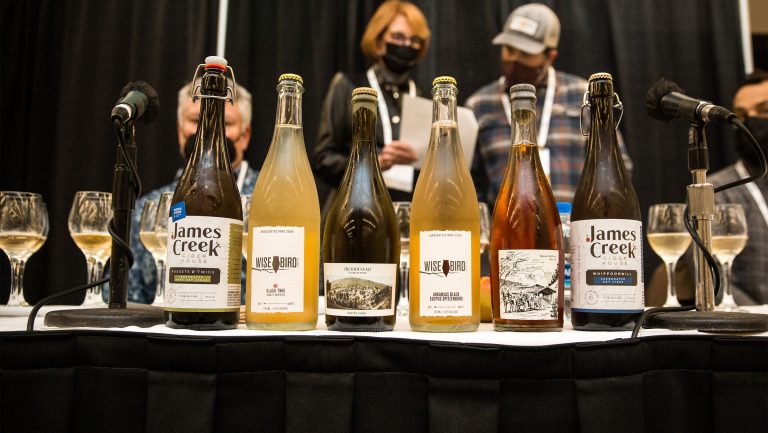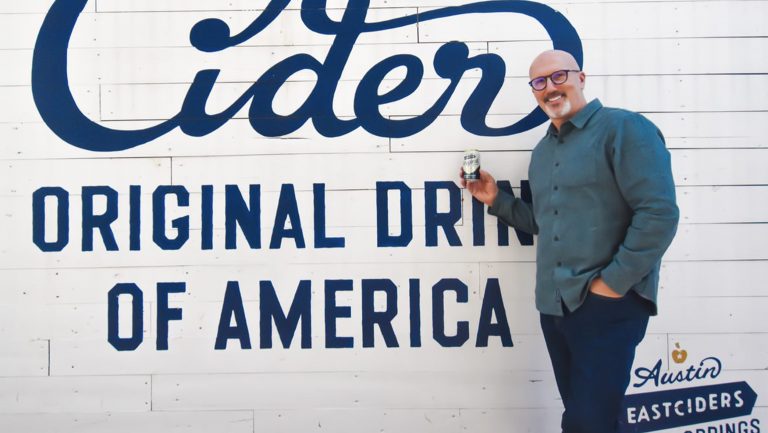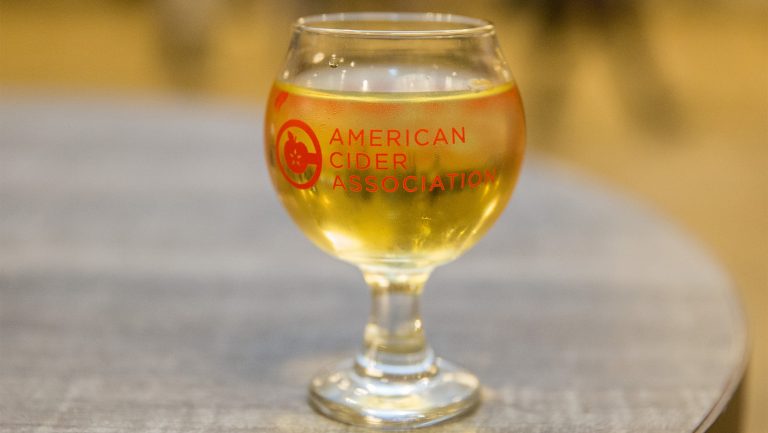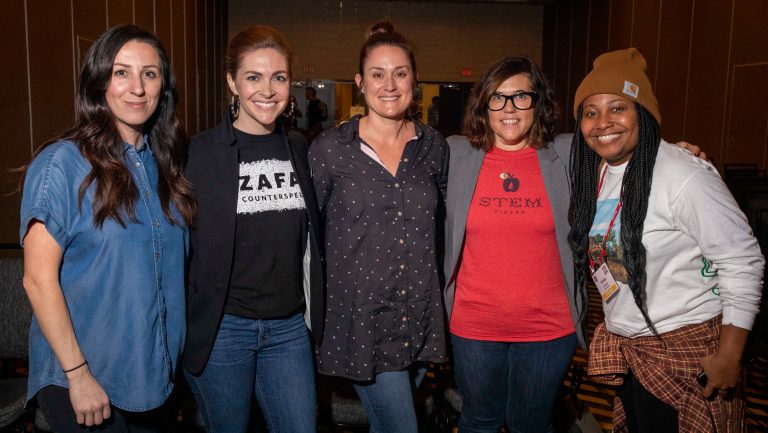In the United States, cider has yet to achieve the mainstream accessibility of wine, the cultural influence of beer, or the sudden success of hard seltzer. But despite its current, modest scope, the cider industry is growing.
However, that growth largely depends on the size of the company making it. Angry Orchard is one of the United States’ top-selling cider brands, but according to 2021 data from Beer Board, a technology company that monitors data from over 7,000 on-premise locations, Angry Orchard is also the only company whose share decreased in year-over-year sales volume, with every other top 10 brand in their report gaining ground.
Beer Board business analyst Dillon Card explains that growth by smaller cideries indicates on-premise accounts are more interested in diversifying their draft lists across beverage alcohol segments. This gives local and regional brands a foothold into cider’s expansion, according to Dave Rule, the vice president of marketing at Austin Eastciders in Austin, Texas.

Don’t miss the latest drinks industry news and insights. Sign up for our award-winning newsletters and get insider intel, resources, and trends delivered to your inbox every week.
“The first macro trend within the category is the movement to craft and independence,” says Rule. “The movement to craft is where beer was 20 years ago, and no one owns it yet.”
As craft cider continues to establish a unique identity, industry leaders and producers are establishing key trends to set cider apart from other segments, hoping to gain ground on dominant national brands, and differentiate themselves from the growing crowd.
Making Sustainability and Climate Change Priorities
Paying attention to sustainability and the science of changing weather conditions is becoming more crucial, says Michelle McGrath, the executive director of the American Cider Association (ACA), pointing to apple harvests affected by catastrophic weather events, such as last year’s “heat dome” over the Pacific Northwest. “The heat dome severely impacted the apple harvest, and one of the consequences that we’re seeing from that is increased juice prices,” she says.
But it’s not just apples—co-fermented fruits like cherries or blueberries may fall out of popular use in favor of more heat-tolerant fruits like guava or prickly pear. McGrath calls climate change’s impact “chaotic” to the future of cider. “The impact of seasons and geography take on a whole new importance when we’re looking at weather devastations to harvest,” she says.

Bettina Ring, the former Virginia secretary of agriculture and forestry and the current chief sustainability and diversity officer at the Sustainable Forestry Initiative (SFI), explains that as the number 10 cider-producing state in the U.S., Virginia’s number one industry is agriculture, followed by tourism and forestry—which all intersect through cider production and consumption.
“The story is so rich as it relates to cider, and there’s so much that we can do while we’re protecting the environment as we grow the industry,” she says, citing up-and-coming producers like Sage Bird Ciderworks in Harrisonburg, Virginia. “They’re being really thoughtful about the products they make, very environmentally focused and wanting to do things in a sustainable way.”
Preparing for More Geographical Diversity
Cider makers in states traditionally inhospitable to commercial apple growing are beginning to emerge, despite an inability to source local apples. One example is Green Bench Mead & Cider in St. Petersburg, Florida.
“Calling Florida a ‘non-orchard-heavy region’ is a bit of an understatement when talking about apples,” says Brian Wing, a co-owner and founder of Green Bench. “I’ve got to drive six or eight hours north before I get to the very southern edge of apple-growing territory.” Though Green Bench sources apples from across the country through relationships with orchardists, Wing sees the project as an opportunity to introduce local consumers to quality, craft ciders.
Cider’s expansion to new, non-orchard-heavy regions is a natural—and necessary—next step in cider’s growth, says Wing. “[I hope] first, the demand for cider fruit goes up even faster than it already is,” he says. “Second, I hope urban cideries can help better influence perception of what cider can be for people who do not live in the traditional cider regions.”
Emphasizing Diversity, Equity, and Inclusion
In 2019, the ACA established an Antiracism, Equity, and Inclusion Committee to educate members on systemic inequity within food and beverage. While the cider industry draws inspiration from activists like Dr. J Jackson-Beckham, the founder of Crafted For All and an equity and inclusion partner at the Brewers Association, McGrath hopes cider will demonstrate the moral and financial value of inclusion to other segments.

“Part of growing the cider industry means making sure everyone’s involved, whether they’re a maker or a consumer,” says McGrath. This means reaching outside of cider into segments like craft beer. In 2022, Beer Kulture partnered with the ACA and ANXO Cidery to offer four scholarships to attend CiderCon and take both levels of the Certified Cider Professional exam.
“I wanted to create something that included an opportunity to experience things like CiderCon, but with a plus one, so recipients can bring someone with them and feel more comfortable,” says Beer Kulture cofounder Latiesha Cook, calling it “daunting” to often be the only Black or brown face in the room. McGrath agrees. “Anybody who’s attended CiderCon can automatically assess that on the surface, it’s a community that could benefit from diverse voices,” she says.
Replacing Other Categories On- and Off-Premise
Rule says that Austin Eastciders’ expansion plan includes producing products that echo other beverages, like beer and spirits, as a gateway for potential cider converts. “If you take a look at double IPAs, you’ve got a clear bridge [to cider] right there,” he says. “You’ve got a consumer base that is ready for it—that’s already there, who’s been drinking IPAs for a long time, who love fruit flavors.”
Marketing efforts are also shifting to include newer Gen Z cider drinkers, who may be ready for something new in light of hard seltzer’s slowed growth. For Gen X and millennials, many bartenders are swapping cider for spirits in their cocktails, according to award-winning author and hospitality historian Tiffanie Barriere (a.k.a. The Drinking Coach). During her CiderCon presentation, Barriere called cider cocktails “the next wave” of American drinks trends for on-premise consumption.
McGrath echoes Barriere’s belief. “The cider industry way over-indexes for on-premise consumption compared to other alcohol segments,” she says. “Cider will outperform your most lagging beer handle [based on Nielsen CGA data].”

Seeking Growth Through Legislative Efforts
Technically (and legally), cider is wine—just using different fruit. “A lot of the regulations for wine are written to protect what makes grape wine awesome, and that has a negative impact, in some cases, on non-grape wines, whether it be cider, co-ferments, or mead,” says McGrath.
The Alcohol and Tobacco Tax and Trade Bureau (TTB) only regulates cider with an ABV of 7% or higher. Ciders with an ABV of 6.9 percent or lower are regulated by the Food and Drug Administration (FDA), who have similar (but not identical) requirements for products.
McGrath points to inconsistencies between current labeling requirements from both bodies, as well as a tax definition that occasionally contradicts both. “Basically, you’re not taxed as a sparkling cider, but they are required to be labeled as a sparkling cider,” she explains as one example of the unpredictable and often illogical rules for cider. This label-to-tax contradiction became an unexpected (and costly) issue when the TTB started rejecting labels with the words “carbonated” or “sparkling” cider over the past few years, prompting a need for cideries to redesign labels and occasionally entire brands.
“Punishing cideries by saying they can’t put ‘pét-nat’ on their labels is crazy,” sighs McGrath. “That’s an example of labeling annoyances that pop up [due] to cider being unique, but still being wine.” Rule jokingly suggests a solution. “Simplify everything and tax us like beer,” he laughs. “That would make us happy.”
Fruited ciders—ciders that have more than just apples or pears—also face financial penalties, despite consumer popularity. “Once we integrate pineapple or any other fruit, it’s a different tax versus the regular ciders,” says Rule. “It’s pretty brutal.” Costs can immediately triple once additional fruit is added. “This is something we’re trying to [change] because there’s a lot of innovation in the co-ferment category,” says McGrath. “It’s really weird all of our competitors don’t have to pay [these] taxes, but fruit wine has to.”
Regulatory confusion, illogical tax structure, and inability to list vintages or harvest dates on labels regulated by Certificate of Label Approval/Exemptions (COLAs) all tie into the ACA’s long-term efforts. “We’re trying to take it really slowly,” says McGrath. “It’s a very complex regulatory world.”
Despite craft cider’s challenges, makers like Rule are optimistic for the future of the industry. “We want cider to grow,” he says. “The door is wide open.”

Dispatch
Sign up for our award-winning newsletter
Don’t miss the latest drinks industry news and insights—delivered to your inbox every week.
Beth Demmon is an award-winning freelance writer that specializes in covering the culture of craft beer and cider. She’s a BJCP-certified judge, Certified Cider Professional, and winner of the 2019 Diversity in Beer Writing grant from the North American Guild of Beer Writers; her work can be found at Good Beer Hunting, San Diego Magazine, and many other publications. Her free monthly newsletter on Substack, Prohibitchin’, features interviews with women and non-binary people working in beverage alcohol.






